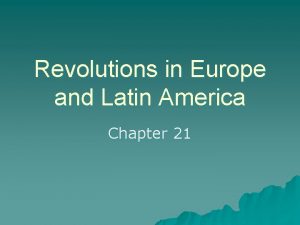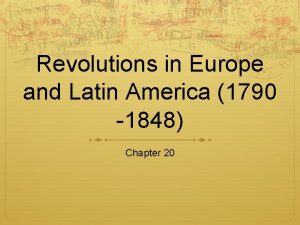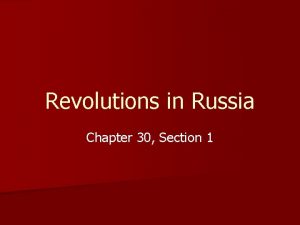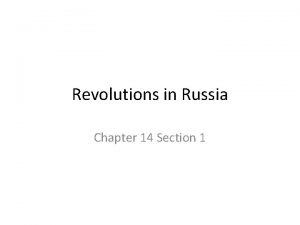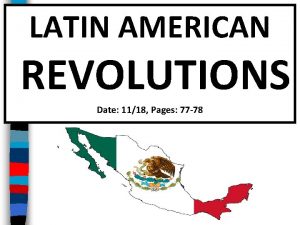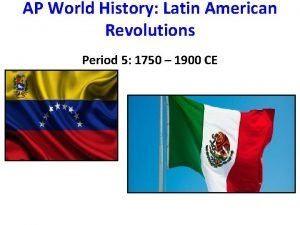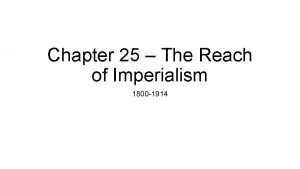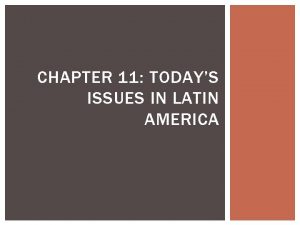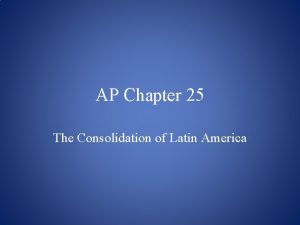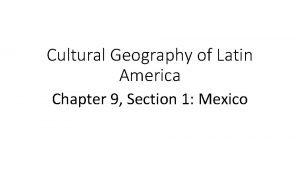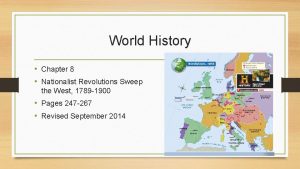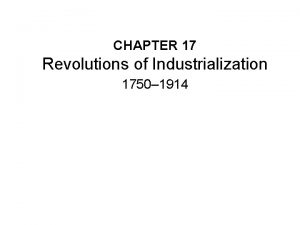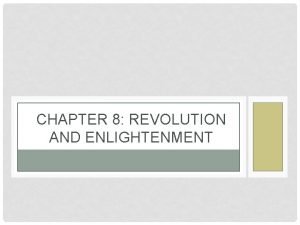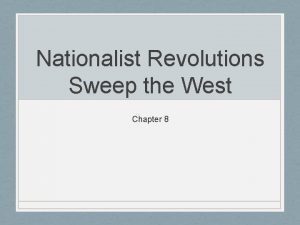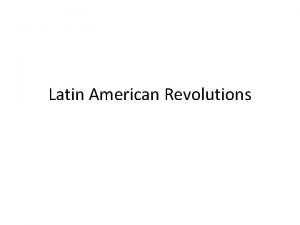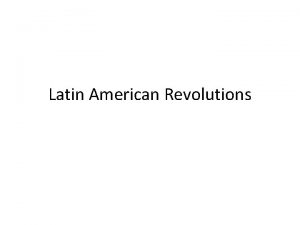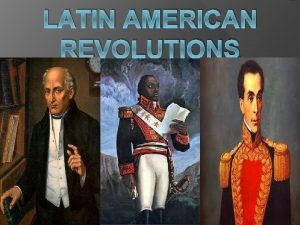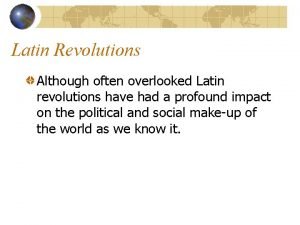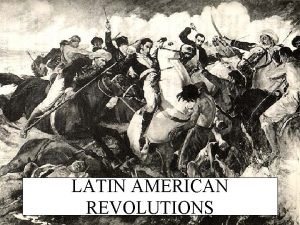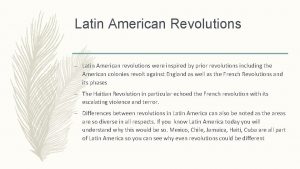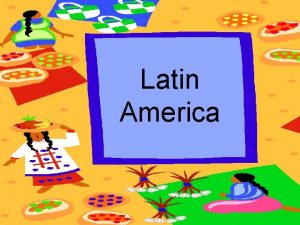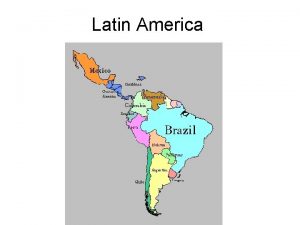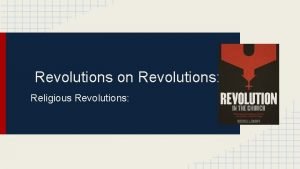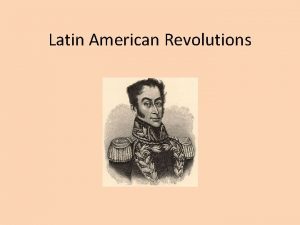Chapter 8 Revolutions in Latin America Section 3
















- Slides: 16

Chapter 8 Revolutions in Latin America Section 3 - Latin American Revolutions Objectives: Ø Explain the causes of discontent in Latin America. Ø Describe Haiti’s fight for freedom. Ø Summarize the revolts in Mexico and Central America. Ø Understand how revolutions ignited South America. Who were the key revolutionaries who led the movements for independence in Latin America, and what were their accomplishments?

Terms and People • peninsular – member of the highest social class in Spain’s colonies in the Americas • creole – American-born descendent of Spanish settlers in Spain’s colonies in the Americas • mestizo – person in Spain’s colonies in the Americas of European and Native American descent • mulatto – person in Spain’s colonies in the Americas of African and European descent • Simón Bolívar – known as “the liberator”; freed several South American nations from European rule, including Venezuela, Peru, Ecuador, and Bolivia • Toussaint L'Ouverture – self-educated former slave who led an uprising against Napoleon in Haiti • Father Miguel Hidalgo – a creole priest who in 1810 called for freedom and an end to slavery for Mexicans; led a revolt • Father José Morelos – mestizo priest who called for wide-ranging reforms in Mexico, including an end to slavery; led a revolt • José de San Martín – an Argentine creole who led armies against colonial rule in Argentina, Chile, and Peru • Dom Pedro – son of the king of Portugal who became emperor of an independent Brazil

After the United States, the first nation in the Americas to win independence was the French colony of Haiti. Enslaved Africans led by Toussaint L’Ouverture began a bloody revolution in 1791. • By 1798 the rebels had taken most of Haiti. • Napoleon sent an army to retake the island. • Despite a truce, they arrested L’Ouverture, who died in France. The French surrendered in late 1803. The following year, Haiti declared itself an independent country.

In Spain’s American colonies, discontent was rooted in the social, racial, and political structure. peninsulares Spanish-born upper class; held top government and church positions creoles Of European descent; resented second -class status; owned mines, haciendas, and ranches mestizos A growing group of people of mixed European and Native American descent mulattoes Africans Of mixed European and African descent; angry about lack of status and opportunities Many were enslaved on plantations and longed for freedom

Educated creoles read Enlightenment writers and saw the North Americans throw off colonial rule. Many traveled to Europe and were inspired by the ideals of the French Revolution. In 1808 Napoleon invaded Spain. Latin American leaders saw Spain’s weakness as an opportunity to win independence.

In most of Spanish America, creoles wanted more power and control. • But most had no desire for economic or social disruption. • The slave revolt in Haiti worried them, because most owned haciendas, mines, or farms. Some used slave labor.

In September 1810 a parish priest, Father Miguel Hidalgo, called for Mexicans to fight for their independence. A ragged army of poor mestizos and Native Americans marched on Mexico City. Despite some early successes, without creole support the rebellion collapsed. Hidalgo was captured and executed.

Another priest, Father José Morelos, took up Mexico’s struggle for independence. He urged reforms such as the abolition of slavery and the right to vote for all men. For four years, rebels with Morelos fought. In 1815 he was taken prisoner and executed. It looked like the rebel movement had ended.

In 1820, liberals forced the Spanish king to issue a constitution for Mexico. • A conservative creole, Agustín de Iturbide, feared that Spain might impose liberal reforms. • Aided by creoles, native Americans, and mestizos, Iturbide overthrew the Spanish viceroy. Mexico became independent. • Iturbide declared himself Emperor Agustín I. But before long, liberal Mexicans toppled him and proclaimed a republic.

During the 1820 s other Spanish-ruled lands in Central America declared independence. At first, leaders set up the United Provinces of Central America. The union quickly fragmented into the separate republics of Costa Rica, Guatemala, Nicaragua, El Salvador, and Honduras.

Simon Bolivar “The Liberator” Venezuelan military and political leader who played an instrumental role in the establishment of Venezuela, Ecuador, Bolivia, Peru and Colombia as sovereign states, independent of Spanish rule. § Born into a wealthy aristocratic Creole family. § Educated in Europe at the age 16 in Spain. § Enlightenment philosophers inspired him with the ambition to replace the Spanish as rulers. § 1808—inaugurated his campaign for independence and within three years an organized national congress had been established. § 1821—The revolutionaries prevailed (Venezuela his).

In 1810 Simón Bolívar led an uprising to create a republic in Venezuela. • The republic was quickly toppled by conservative forces, who forced him into exile. • However, Bolívar responded with a daring plan.

Bolívar and his army crossed the Andes; in August 1819, he surprised the Spanish in Bogotá, now capital of Colombia. Other victories followed; by 1821 Caracas was free. Bolívar moved on to Ecuador, Bolivia, and Peru. Now called “The Liberator, ” he joined forces with José de San Martín.

In 1816 José de San Martín helped win independence for Argentina. • He then led an army over the Andes to defeat the Spanish in Chile. • Moving next to Peru, he turned his forces over to Bolívar, who was victorious. By 1824, the new nation of Gran Colombia was free. However, rivalries caused the nation to split into Colombia, Panama, Ecuador, and Venezuela. Bolívar was also bitterly disappointed as power rivalries led to destructive civil wars.

Under Dom Pedro, son of the Portuguese king, Brazil became an independent nation. When Napoleon conquered Portugal, Dom Pedro fled to Brazil. • In 1822, Portugal threatened to end reforms in Brazil. • Dom Pedro declared himself emperor of a free Brazil. • He accepted a constitution and many freedoms. • Brazil remained a monarchy until 1889.

Who were the key revolutionaries who led the movements for independence in Latin America, and what were their accomplishments? Liberal ideas spread to Latin America with explosive results. After 300 years of colonial rule, revolutionary movements from Mexico to South America overthrew European powers. By 1825, most of Latin America had won independence.
 Revolutions in europe and latin america section 2 quiz
Revolutions in europe and latin america section 2 quiz Why is called latin america
Why is called latin america Revolutions in europe and latin america
Revolutions in europe and latin america Chapter 30 revolutions in russia
Chapter 30 revolutions in russia Chapter 14 section 1 revolutions in russia answer key
Chapter 14 section 1 revolutions in russia answer key Latin american revolutions date
Latin american revolutions date Ap photo
Ap photo The reach of imperialism vocabulary activity
The reach of imperialism vocabulary activity Chapter 11 today's issues in latin america
Chapter 11 today's issues in latin america Chapter 25 the consolidation of latin america
Chapter 25 the consolidation of latin america Vocabulary activity 9 cultural geography of latin america
Vocabulary activity 9 cultural geography of latin america Chapter 8: the physical geography of latin america answers
Chapter 8: the physical geography of latin america answers Chapter 8 nationalist revolutions sweep the west
Chapter 8 nationalist revolutions sweep the west Atlantic revolutions global echoes
Atlantic revolutions global echoes Chapter 17 revolutions of industrialization
Chapter 17 revolutions of industrialization Chapter 8 the enlightenment and revolutions
Chapter 8 the enlightenment and revolutions Which ideas of romanticism would encourage nationalism?
Which ideas of romanticism would encourage nationalism?
